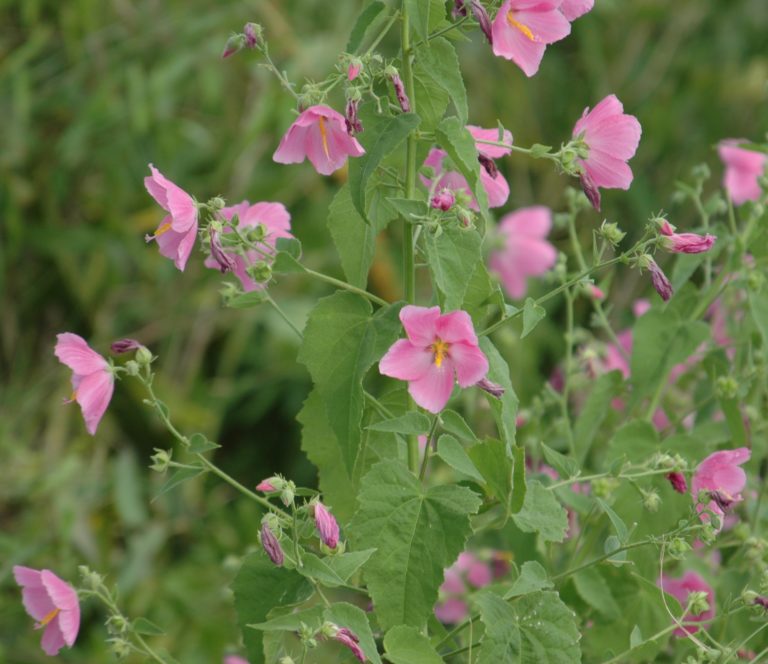Seashore Mallow is a lovely, salt tolerant herbaceous perennial (some call it a subshrub) native to the Eastern shore of the U.S. The toothed, roughly triangular leaves and stems are softly hairy with tiny stellate (star-shaped) hairs. An obligate wetland plant, it thrives in full sunlight and wet soil. It is commonly grown very successfully in average garden soil as well, but it must not be allowed to totally dry out. Seashore Mallow is late to emerge in spring but it attains full size by July when many small (2-3″), delicate, hibiscus-like flowers begin to appear, from pale to deep pink, in the axils of the leaves and in terminal panicles. Five petals surround an amazing, prominent golden structure consisting of fused stamens and styles. Flowers each last one day, but there are many of them, and the blooming period is long, continuing into November most years. Seashore Mallow grows larger each year, reaching 5′-6′ in five or so seasons, at which time it might be a good idea to replace it with a younger individual. The Virginia Wildflower of the Year in 2004.
NURSERY HOURS
Wednesday: 10-4 Thursday: 10-6 Friday-Saturday: 10-4 Sunday: 12-4
Kosteletzkya pentacarpos, previously known as Kosteletzkya virginica

Key Info
Scientific Name: Kosteletzkya virginica (L.) C. Presl ex A. Gray
Common Names: Seashore Mallow, Virginia Saltmarsh Mallow, Virginia Fen-rose, Salt Marsh Mallow, Seaside Mallow, Marsh Mallow, Pink Mallow, Sweatweed
Family Names: Malvaceae (Cotton or Mallow Family)
Plant Type: Herbaceous perennial
Light Requirement: Full sun
Leaf Retention: Deciduous
Flower Color: pink
Special Characteristics: Long blooming period, Fast growing, Tolerates wet conditions, Rhizomatous, Attracts butterflies, Salt tolerant, Attracts Hummingbirds
Additional Info
Habit: A strongly vertical, much-branched and angular subshrub or herbaceous perennial in habit. Each clump has a few very tall, thick stems with many short side branches on the upper two-thirds. These tall stems are generally self supporting, especially if light is not strongly one-sided. Leaves are relatively large and evenly distributed on upper portions of the stems. Stems grow from a tough crown of roots which supports a shallow, thick, far-reaching root system. Suckering is reported, but not problematic.
Height: 3' to 5'
Spread: 3' to 4'
Soil Conditions: Average to wet, acid or alkaline, brackish water, shallow, standing fresh water, garden soil.
Leaves: The upper leaves are alternate, simple, greyish green, 3 to 6 inches long and half as wide, with somewhat variable shape. Usually the leaves are spear-shaped with spreading basal lobes, singly or doubly serrated, densely pubescent with star-shaped hairs on both surfaces. Lower leaves are maple-like with 3-5 lobes.
Flowers (or reproductive structures: Stalked, perfect flowers are borne singly in the leaf axils or in terminal, leafy panicles. Flowers are 2 to 3" across with 5 pale to deep pink (occasionally white), spreading petals up to 1.5 in long and wedge-shaped, but rounded at the tip. The numerous (20-30) stamens are fused in a column around the pistil and its 5 styles, which are capped by pinhead-like stigmas. Very long bloom time.
Fruit: The 5-celled pistil matures into a flattened, 5-segmented and angled dehiscent capsule, less than a half-inch across and bearing 1 seed per segment.
Natural Distribution: Seashore mallow grows in salt, brackish, and almost fresh marshes and other wet habitats on the outer coastal plain from New York and Delaware to Florida and Texas.
USDA Hardiness Zone: 6 to 9
USDA Wetland Indicator Status in NC: OBL
Pollination: Bees, butterflies, other insects; occasionlly self-pollinated ("delayed selfing" -- see Cultural Notes)
Wildlife Connections: Attracts hummingbirds. Reports on susceptibility to deer are mixed.
Propagation: By seeds
